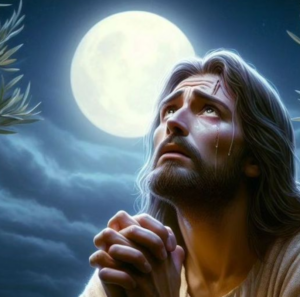Then Moses called for all the elders of Israel and said to them, “Pick out and take lambs for yourselves according to your families, and kill the Passover lamb. And you shall take a bunch of hyssop, dip it in the blood that is in the basin, and strike the lintel and the two doorposts with the blood that is in the basin. And none of you shall go out of the door of his house until morning. For the Lord will pass through to strike the Egyptians; and when He sees the blood on the lintel and on the two doorposts, the Lord will pass over the door and not allow the destroyer to come into your houses to strike you. And you shall observe this thing as an ordinance for you and your sons forever. Exodus 12:21-24
Christians know the story of Passover well. God called every family in Israel to kill a lamb, and paint its blood on the doorposts of their homes in Egypt. Everyone who entered the house, through the bloodstained entrance, would be safe when the destroyer come to take the lives of the firstborn of the Egyptians.
Passover became an ordinance to be celebrated year after year to commemorate Israel’s deliverance from their oppressors. Today we know that Passover was a prophetic institution, a shadow that eventually found its substance in Christ. The Son of God Himself became the Passover Lamb that promises safety from eternal death to all who choose Jesus as the Sacrificial Lamb for their sins. Jesus is the blood stained door to that safe place.
I am the door. If anyone enters by Me, he will be saved, and will go in and out and find pasture. John 10:9
Sadly enough, Passover today is associated with eggs and bunnies, and is even called by the pagan name of Easter.
There is absolutely no connection whatsoever between Easter and Passover. Easter is at best actually a major distraction from the important message of salvation that is expressed in the Passover ritual. It should be no surprise that the devil found a way to hide the good news of salvation behind a feast of his own making.
The Passover lamb that the Israelites had to choose was to be without blemish; they could not take an imperfect lamb of little value for such an important event. This important detail had deep meaning for the final Passover that would happen down the ages: Jesus Himself was “inspected” by Pilate and Herod, and both found Him to be innocent, for had He any guilt, He would have died for His own sin. However, because He was found to be without fault, He qualified to die for ours – the innocent for the guilty.
The blood of the sacrificial lamb also played a central role on the Day of Atonement. In the Old Covenant the high priest entered the Holy of Holies behind the veil, once a year, to sprinkle its blood on the lid of the Ark of the Covenant in the manifest presence of God. This was the most important day on the Jewish calendar, and the people were waiting outside for the priest to emerge from behind the veil after he performed his duty there. If God accepted the sacrifice, it meant that their sins were covered by the blood, and that they could count on His blessing for another year.
Something very powerful happened when God’s Sacrificial Lamb shed His blood on the cross: shadow turned into substance, even while Passover lambs were being slaughtered in the annual Passover ritual throughout Israel.
And Jesus cried out with a loud voice, and breathed His last. Then the veil of the temple was torn in two from top to bottom. Mark 15:37,38
The curtain that separated the Holy Place from the Holy of Holies where the Ark of the Covenant stood, was torn from top to bottom – an act of God Himself. Suddenly, the Holy of Holies that was hidden from sight for centuries, was exposed. It is commonly believed that it was God’s way of inviting common people into His presence, something that was the privilege reserved for the high priest only. However, it is my opinion that much more was revealed at that momentous moment.
First of all, when the veil was torn the emptiness of ritualistic religion was exposed. The Ark had been removed centuries before, presumably at the destruction of Jerusalem by the Babylonians in 587BC, and wasn’t there anymore. As a matter of fact, the Ark never stood in the second Temple.
Much can be said about this incident. As mentioned above, it became known that the Holy of Holies was empty, making it obvious that the sprinkling of blood on the lid of the Ark could not happen since the destruction of the second Temple, (The New Bible Dictionary page 111).
Secondly, as Jesus’ blood flowed down the cross, the need for atonement was fulfilled once for all. The sacrificial blood that was sprinkled on the mercy seat on earth was no longer required, so the use of the Holy of Holies in a tabernacle made by hands became obsolete.
But Christ came as High Priest of the good things to come, with the greater and more perfect tabernacle not made with hands, that is, not of this creation. Not with the blood of goats and calves, but with His own blood He entered the Most Holy Place once for all, having obtained eternal redemption. Hebrews 9:11,12
Thirdly, there is no need for an earthly high priest to mediate between man and God anymore. Jesus became our High Priest. Since He knew what it was to endure temptation, yet without sin, He became our compassionate High Priest who intercedes for us at the right hand of the Father. (Hebrews 7:25) Not only that, through Him we have a standing invitation to enter boldly into the Throne Room when we need mercy and grace. (Hebrews 4:16)
Lastly, the tearing of the veil announced the end of the Old Testament era with its ritualistic service. The prophetic picture of Passover became reality when the final Passover Lamb gave His life for the sin of the world. But something of equal – if not greater – importance happened three days later when Jesus rose from the dead, never to die again! His resurrection is proof of our justification:
(Jesus) …who was delivered up because of our offences, and was raised because of our justification. Therefore, having been justified by faith, we have peace with God through our Lord Jesus Christ, through whom also we have access by faith into this grace in which we stand, and rejoice in hope of the glory of God. Romans 4:25- 5:1,2
His resurrection introduced the church age – the era of grace – in which we have the privilege to live.
Finally, everyone in old Israel had to pass through the blood stained door into safety – a prophetic finger that pointed to life under the New Covenant. Let us celebrate our own personal Passover, rejoicing in the glorious grace of God that wooed us to enter through the blood of Jesus to safety from the destroyer of our souls. And on Sunday, Resurrection Day, we celebrate our own resurrection from the death of sin.
And you He made alive, who were dead in trespasses and sins, in which you once walked according to the course of this world, according to the prince of the power of the air, the spirit who now works in the sons of disobedience… Ephesians 2:1,2
With Passover approaching, let’s go back to the Bible, and celebrate the real reason in a God-honouring way. This feast is about Jesus, Who did the impossible for us who once were without hope. While the world celebrate Easter, let us celebrate Passover!


